#orange pore fungi
Explore tagged Tumblr posts
Text


Just back from a mini break in Cornwall. Found loads of Orange pore fungus, Favolaschia calocera at the Lost Gardens of Heligan!
#fungi#mushroom#mycology#nature#nature photography#photography#mushrooms#toadstools#forest#cornwall#Lost Gardens of Heligan#Heligan#orange pore fungi#Favolaschia calocera#tw trypophobia
180 notes
·
View notes
Text
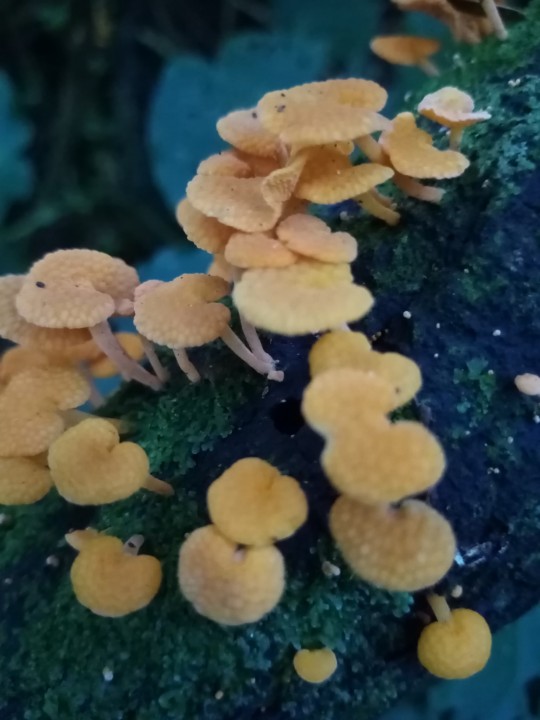
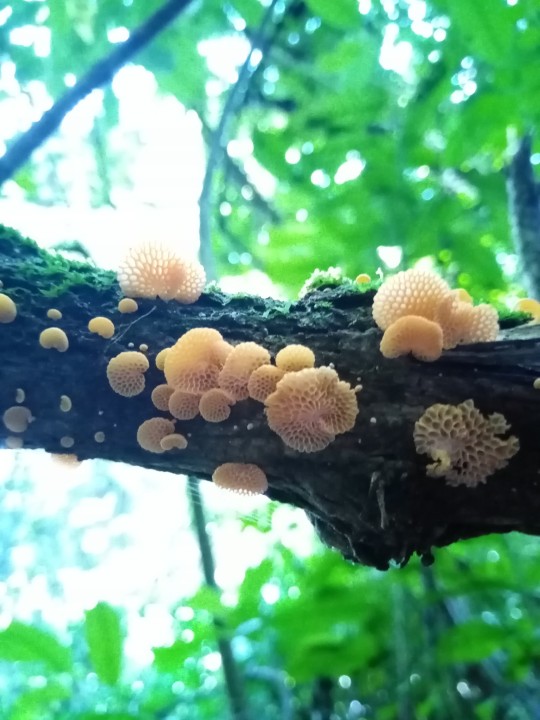
Orange Pore Fungi
3 notes
·
View notes
Text
FOTD #039 : orange ping-pong bat! (favolaschia calocera)
the orange ping-pong bat (AKA orange pore fungus or orange pore conch) is an invasive fungus in the family mycenaceae. it inhabits wood, & has been found in madagascar, aotearoa, italy, spain, great britain, portugal, france, switzerland, belgium, the netherlands, venezuela, brazil, peru, costa rica, the islands of hawaii, australia, kenya, DR congo, tanzania, zambia, seychelles, thailand, china, & india, but it may be more widespread.
the big question : can i bite it?? nah, it is inedible.



f. calocera description :
"f. calocera is a wood-inhabiting saprotrophic fungus. it often has a bright yellow color at first, & can later appear in a brownish yellow color, though it often presents as a bright orange stalked fan, 5 mm–30 mm diameter, with prominent pores on the underside."
[images : source, source & source] [fungus description : source]
#• fungus of the day !! •#[favolaschia calocera]#: orange ping-pong bat :#: orange pore fungus :#: orange pore conch :#039#||#cw trypo#fungi#fungus#mushroom#mushrooms#cottagecore#earth#forestcore#foraging#mycology#nature#favolashia calocera#orange pore fungus#fotd#fungus of the day#orange pore conch#orange ping-pong bat#trypo#tw trypo#trypophobia
86 notes
·
View notes
Text

Orange pore fungus (Favolaschia)
Photo by Joao Burini
#orange pore fungus#favolaschia#fungi#fungus#pore fungus#orange#orange fungi#colorful fungi#macro photography#nature
4 notes
·
View notes
Note
caregiver!ellie is sooo cute but wha about caregiver!reader…
i jus wanna play with her hair n tell her how amazing she is…😞
ughh anon ur in luck cuz I always had the perfect scenario for this in mind. a little tired rn but I'll try, so here we go!! SFW, bit angsty if you squint?? moreso sappy. ✰ . . TLOU UNIVERSE

rust of blood, a scent that churns nostrils and sickens guts. that scent, nested in your nose as you led ellie into the bathroom, embossing crimson prints in each step. damn infected, right? cramming their ridgy fungi bodies through painstakingly set traps– little fuckers weaseled upon your property. nothing to fret about, els was there– as usual– to mow them down to the bone. but everytime, would return a person so done with this bullshit, her own bullshit. gushy assumptions that leave her feeling a tad peeved that she couldn't 'do better for you', when all she gave you was betterness, everyday. it's the little things that tick her off. the little things that sparsely matter to you.
"arms up." you asked, so brittle– so fine. fine on the ears roughened– reddened, scars prevail. with her wearied ass sat atop the baths' edge, you felt nothing waned from nurturing. that beaten freckled face, so preciously relying on you to care for her. ellie draws her arms up, stiller then bark when you tuck and pare her soiled shirt off, plaid pattern muddled by a likeness of bloodshed. you dip down, knees bound to a squat, popping her fly open and rolling the denim up and off her legs. els didn't really utter much. she was really tired, bone–tired. so, with the rest of her clothes messily assorted in a pile at your feet, you arise, guiding her with a shoulder tap. "c'mon–" the clear water welcomes her body, fingertips rubescent as they dig into the white tubs' edge, sinking in slowly. a soft grunt flows from her nose, water rippling as her elbows drift to her flank. you sidle upon a stool beside her, soaked rag in hand, it drips. the drops, they find their way onto els' spent skin of tender bruises. there's a certain breed of kindness that one's hands will pamper along the body of a lover, your hands, her body, a doting kindness. you swipe the rag up her scruff, taking gentle time on the groove where jaw and neck weave in flesh. she reciprocates in pleased buzzes, hums to show an unwaver of contentment. raggy bristles tickle her skin, running along the pistil pores, so smoothly– she just has to let you know, "m'not gonna lie, this is nice." and dreary lids flip to creased ones, uplifted by a fat–cheeked beam. a girl could used to this, after starving of its attention, for so long, years and tears hence. she adds with rasp, an irritated rasp, "fucking stupid of me for not checking the perimeters, m'so dumb, i should've–" she scolds herself, and you scold threefold– kindly, "infected, are fuckin' stupid. not you, babe." it baffles you to even hear her words of self–scorn perk on your ears, you affirm further, "you're so smart for even suggesting the traps in the first place, don't even say that." your available hand skids up her back, knurling knuckles in her pappy wet tuft and pressing a strand to your thumb, "never, say that." you repeat nimbly, lacking tone, pitching in breath. the strand you press, it oozes more drops like a squashed orange, pulping to your mold of it. she smiles wider, and wider, till finally– her teeth held in place. null troubles could sweep those cheeks of dimples. then her lips cleave, and that coral tongue begins to wag again, muttering, "fuck, you're so sweet." then, bowing her head in amusement of her words, she muttered softer than prior, "too sweet." a smile she lifts somehow further, bathwater wets her rosy cheeks– a glisten hardly unnoticed in dim candle blaze.
and what is encouraged beyond those words, is your velvet kiss to her wrist, catching and craning it up to meet your mouth. you sow it, palp it, suckle it, and squeak with a pop, surfing straight into your praise of, "but you're my sweet girl.." moseying the rag down the span of her bicep, mellowly.
"shut up.."

(img from fulltimekardashian on pinterest)
#ellie williams#⤹𓍢ִ໋aestras asks#ellie williams x reader#ellie williams fluff#ellie tlou#ellie x reader#lesbian#sapphic#ellie williams x fem!reader#ellie williams fic#ellie williams concept#ellie williams blurb#ellie williams drabble#ellie williams fanfic#ellie williams fanfiction#ellie williams x you#ellie x fem reader#ellie x you#ellie x y/n
282 notes
·
View notes
Text
How to Identify Chicken of the Woods Mushrooms
Originally posted n my website at https://rebeccalexa.com/how-to-identify-chicken-of-the-woods/. Click here to learn more about the How to Identify article series.
Name: Chicken of the woods (Laetiporus spp.), aka sulfur shelf, chicken mushroom (hen of the woods is a different mushroom entirely, Grifola frondosa)
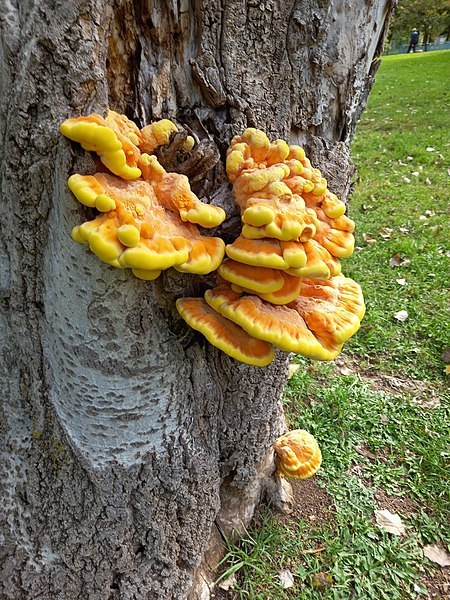
L. sulphureus
Range and typical habitat(s): There are Laetiporus species found in temperate forests on every continent except Antarctica. They are especially abundant in the Northern hemisphere, particularly North America and Europe. They are saprophytes that feed on dead or injured trees and can cause brown rot as they digest cellulose but leave lignin intact. Most species prefer deciduous trees such as oaks or beeches. However, L. conifericola is an example of a species that colonizes conifers such as spruces and firs.

Distinguishing physical characteristics (size, colors, overall shapes, detail shapes): I often describe chicken of the woods to my foraging students as looking like a pile of orange and yellow pancakes exploding out of the side of a tree. These are fleshy-looking, shelf-shaped mushrooms that often grow in large stacks or clusters. A particularly large individual shelf may be almost a foot across, and some clusters may be several feet tall. Look closely, and you will notice that these shelves do not have stems but attach directly to the host tree.
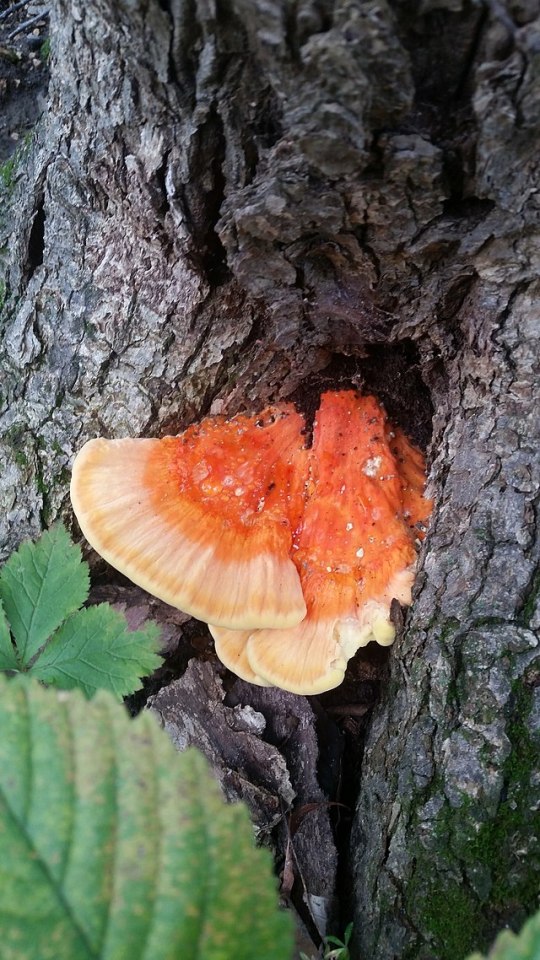
A specimen of L. sulphureus displaying a darker orange with pale orange instead of bright yellow margins.
While the bright sulfur yellow and orange color combination is typical, particularly in well-known chicken of the woods species such as L. sulphureus, there may be significant color variation even within the same species. Some have a deeper orange that’s almost red, while others are a more uniform washed-out orange with little to no yellow, or perhaps cream instead. L. portentosus, which is particularly common in Australia, gets its common name, “white punk”, from its creamy white color with little to no orange. L. persicinus, found in the southeast United States and Caribbean, may have some brown on its shelves as well.

L. conifericola, displaying the yellow pore surface underneath. RTehan at Mushroom Observer, CCA-SA-3.0
The underside of chicken of the woods tends to be yellow to cream, and while it may appear smooth at first it does have very fine pores. The spores are generally white, though a microscope may be necessary in order to differentiate between very similar species that overlap in range. Most Laetiporus species do not bruise; however, L. persicinus has pores that bruise brown shortly after being damaged.
Younger chicken of the woods tend to have a softer, more rubbery tactile texture (yes, it’s okay to touch mushrooms to see what they feel like.) As they get older, however, they get a tough, woody texture, and cooking them does not make them tender again.
Other organisms it could be confused with and how to tell the difference: Most of the time you’re going to be differentiating among multiple Laetiporus species, in which case location, color and substrate (what kind of tree it’s growing on) are going to be the main factors in identifying down to species level. If you have a microscope and want to look at the spores in detail you’re certainly welcome, but the casual identifier should be able to get by without this.

Dyer’s polypore (Phaeolus schweinitzii)
There are, however, several other shelf-like fungi with which chicken of the woods may be confused if you aren’t looking carefully. Dyer’s polypore (Phaeolus schweinitzii) may have some orange on the upper surface, especially when young, but the centers turn an increasingly dark brown as the mushroom matures. It also has a velvety texture that chicken of the woods lacks. It is found primarily on conifers, and the pores bruise brown when damaged. It has a white spore print.

Woolly velvet polypore (Onnia tomentosa)
The woolly velvet polypore (Onnia tomentosa) is another look-alike. It is generally brown with a white to cream outer margin, but while the lighter brown shades may have a bit of an orange tint, the brown is a giveaway that this is not chicken of the woods. The underside is also brown, rather than white or yellow, and it primarily grows on conifers, especially spruce.

Pycnoporus cinnabarinus
Pycnoporus cinnabarinus looks very much like a Laetiporus in shape, but is a bright red-orange color on both the top and the underside. It has a drier, less flexible texture as well, and prefers hardwood trees as hosts.
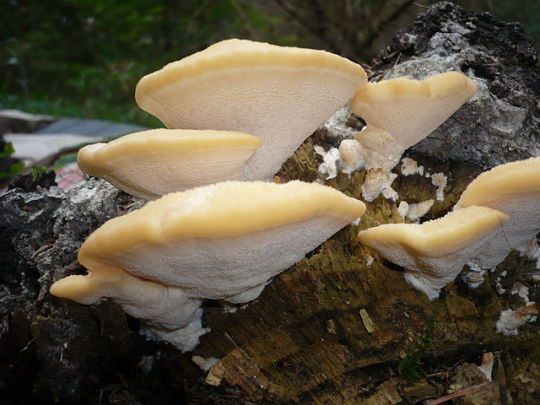
Climacocystis borealis. Gerhard Koller at Mushroom Observer, CCA-SA-3.0
Climacocystis borealis has a hairy texture on the upper surface, and the color is a rather dull cream, yellow or orange, Underneath the pores are cream to yellow and have a more visible texture than on Laetiporus. It attaches to its host conifer trees with a short stem-like structure.

Hen of the woods (Grifola frondosa). Patrick Harvey, CCA-SA-3.0
Hen of the woods (Grifola frondosa), also known as maitake, looks something like a burst of grayish-brown feathers or leaves sprouting from the base of a tree. Upon closer inspection the individual caps are much smaller, more delicate and more numerous than in Laetiporus. The pores underneath are often more visible as well. They prefer hardwoods such as oaks.
There are other shelf-shaped mushrooms in the family Fomitopsidaceae that are vaguely similar to Laetiporus species, but all differ in shape and color, among other details. Make sure you look very closely at all colors on both the topside and underside of a given shelf mushroom, check for bruising by cutting or crushing a small part and waiting a half hour, and take a spore print.
Anything else worth mentioning? Laetiporus species are generally considered to be edible, though more commonly eaten species like L. sulphureus have more documentation in this regard than less common species. Its common name comes from the cooked mushroom’s resemblance to cooked chicken meat, and it is often used as a vegetarian meat alternative in recipes.
Care should be taken when consuming any Laetiporus species for the first time, even if you have eaten other species of the genus with no problem. Research each species as though you had never encountered chicken of the woods before, and make sure that species is considered safely edible by current standards.
A small number of people who eat chicken of the woods experience unpleasant symptoms ranging from gastrointestinal upset to swollen lips or mouth and dizziness. This may be due to allergic reactions, so caution is absolutely necessary. Always cook wild mushrooms, including Laetiporus, thoroughly; try a few bites, then wait a couple of days to see if you have any symptoms.
Further reading:
Mushroom Expert: Laetiporus
Chicken of the Woods
Chicken Of The Woods (Laetiporus sulphureus Species Complex)
Chicken of the Woods (Laetiporus sulphureus)
Chasing the Chicken of the Woods (Facts, Identification, and Recipes)
Did you enjoy this post? Consider taking one of my online foraging and natural history classes or hiring me for a guided nature tour, checking out my other articles, or picking up a paperback or ebook I’ve written! You can even buy me a coffee here!
#mushroom#mushrooms#mushroom hunting#mushroom foraging#foraging#edible mushrooms#fungi#fungus#mycology#nature identification#nature#ecology#chicken of the woods#wild mushrooms#cooking#food
45 notes
·
View notes
Text
Foraging Chicken of the Woods
If you’re a beginner forager, you’ve probably heard about Chicken of the Woods! They’re a decomposing mushroom that lives on dead and/or dying wood. You’ll often see them on standing trees that appear otherwise healthy, but their presence is a clear indicator of rot.
I’m going to tell you how to forage this delicious and colorful fungi for yourself so you can embrace the wonderful culinary experience of Chicken of the Woods!
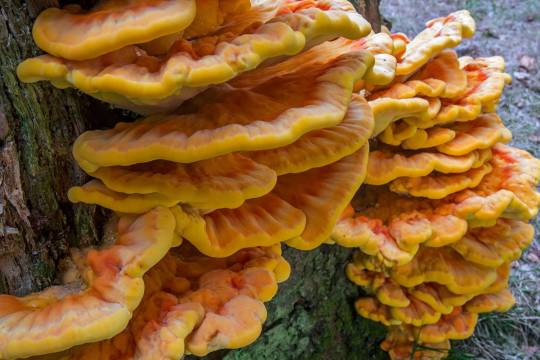
All mushrooms in the laetiporus genus are known as “chicken of the woods” but the most common (in the northeast) is Laetiporus sulphureus.
Where and When To Find Them:
*I will be focusing on the United States as an area of focus on this post*
These mushrooms will differ in their time of appearance depending on where you live. Warmer locations deeper in the South will see these mushrooms in spring, while cooler locations may not be able to see Chicken of the Woods until August/September.
Identification:
There is an unmistakable yellow/orange color of Chicken of the Woods that tends to make it easily identifiable from a distance. The fungi grows in shelf-like clusters on either standing or fallen trees. Said shelves will have grown parallel to the ground, unless the tree has just very recently fallen.
A key identifying characteristic is the lack of gills on the underside. Instead of the characteristic gills that many people associate with other mushrooms, you should see many small (almost microscopic) pores throughout the bright yellow under surface.

When they’re in prime condition, the underside or pore surface of this mushroom will be a bright yellow color. As they grow past their prime, this color will become more white and faded in shade.
Culinary Applications:
It is important to note that this mushroom should be properly cooked in order to avoid the chance of potential upset stomach side effects. As with any mushroom (harvested from the wild or otherwise) it is always possible to have an adverse reaction to Chicken of the Woods.
Keep them refrigerated until you’re ready to use them, but take note that they won’t keep more than a week. They need to be used quickly, or otherwise preserved to maintain their use in the kitchen.
#herbs#herbalism#foraging#forager#witch#witchy#wicca#witchcraft#green witch#kitchen witch#green witch recipe#kitchen witch recipe#recipe
12 notes
·
View notes
Text
12 Fungi You Must Avoid
According to reputable tree loppers Sydney, fungi are fascinating organisms that play an essential role in the environment. They decompose organic matter, recycle nutrients, and form symbiotic relationships with plants and animals. However, not all fungi are harmless. Some species can produce toxins that can cause serious illness or even death if ingested.
The list below discusses the fungi that grow on or near trees that you should avoid touching or eating. These fungi can cause a variety of symptoms, including nausea, vomiting, diarrhea, and liver damage. In some cases, poisoning can even be fatal.
Death Cap (Amanita phalloides)
The death cap is one of the most poisonous mushrooms in the world. It is responsible for more mushroom poisoning deaths than any other species. The death cap is a large, white mushroom with a pale green or yellow cap. It has a skirt-like ring around the stem and white gills.
Destroying Angel (Amanita virosa)
The destroying angel is another deadly mushroom that closely resembles the death cap. It is a large, white mushroom with a pale green or yellow cap. It has a skirt-like ring around the stem and white gills.
False Morel (Gyromitra esculenta)
The false morel is a poisonous mushroom that resembles the true morel, a popular edible mushroom. False morels are typically larger and have a more wrinkled or convoluted cap than true morels. They also have a distinctive reddish-brown colour.
Jack-o'-lantern (Omphalotus olearius)
The jack-o'-lantern is a poisonous mushroom that glows in the dark. It is a small, orange mushroom with a funnel-shaped cap. It has gills that are white to yellowish-brown.
Galerina marginata
Galerina marginata is a poisonous mushroom that grows in clusters on dead wood. It is a small, brown mushroom with a bell-shaped cap. It has gills that are brown to reddish-brown.
Lepiota brunnea
Lepiota brunnea is a poisonous mushroom that grows in clusters in grassy areas. It is a small, brown mushroom with a bell-shaped cap. It has gills that are white to yellowish-brown.
Chlorophyllum molybdites
Chlorophyllum molybdites is a poisonous mushroom that grows in clusters in grassy areas. It is a large, green mushroom with a bell-shaped cap. It has gills that are yellow to green.
Clitocybe illudens
Clitocybe illudens is a poisonous mushroom that grows in clusters in grassy areas. It is a small, white mushroom with a bell-shaped cap. It has gills that are white to cream-coloured.
Cortinarius rubellus
Cortinarius rubellus is a poisonous mushroom that grows in clusters in forests. It is a small, orange mushroom with a bell-shaped cap. It has gills that are yellow to orange.
Entoloma rhodopolium
Entoloma rhodopolium is a poisonous mushroom that grows in clusters in forests. It is a small, pink mushroom with a bell-shaped cap. It has gills that are pink to reddish-brown.
Paxillus involutus
Paxillus involutus is a poisonous mushroom that grows in clusters in forests. It is a large, brown mushroom with a funnel-shaped cap. It has gills that are orange to reddish-brown.
Boletus Satanas
Boletus Satanas is a poisonous mushroom that grows in clusters in forests. It is a large, red mushroom with a bulbous stem. It has pores that are yellow to orange.
What to Do If You Think You Have Been Poisoned by a Mushroom
If you think you have been poisoned by a mushroom, it is important to seek medical attention immediately. Do not try to identify the mushroom yourself, as this could delay treatment. Symptoms of mushroom poisoning can vary depending on the species of mushroom, but they can include nausea, vomiting, diarrhea, abdominal cramps, liver damage, and kidney failure.
Preventing Mushroom Poisoning
The best way to prevent mushroom poisoning is to avoid eating wild mushrooms. Only eat mushrooms that have been purchased from a reputable source. If you are unsure about a mushroom, do not eat it.
It is also important to teach children about the dangers of mushroom poisoning. Children should be taught not to touch or eat any wild mushrooms.
Fungi can be beautiful and fascinating organisms, but they can also be dangerous. It is important to be aware of the dangers of mushroom poisoning and to take steps to prevent it.
0 notes
Text
FOTD #035 : cracked cap polypore! (phellinus robiniae)
the cracked cap polypore (AKA cracked bracket & medicinal cracked cap polypore) is a parasitic bracket fungus in the family hymenochaetaceae. they occur in south africa, europe, canada, the US, mexico, costa rica, brazil, australia, kenya, zambia & zimbabwe !!
the big question : can i bite it?? this fungus is inedible (due to its toughness), but has medicinal uses.
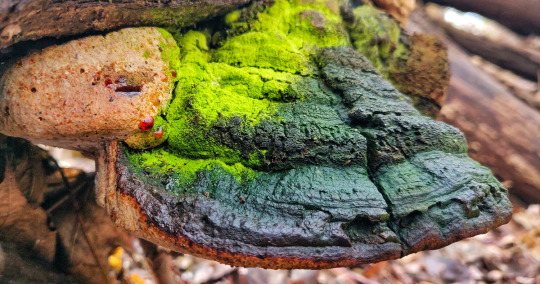
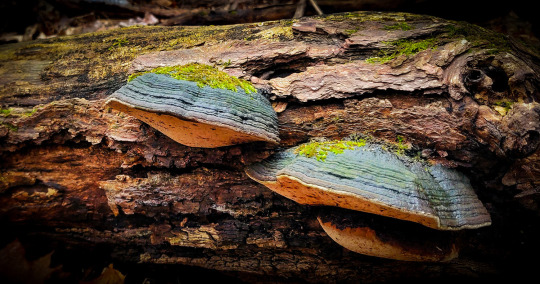
p. robiniae description :
"this is one of a number of species with a hard, cracked fruit body. the cap is 3-36cm in diameter & 1,5-28cm thick. it is woody in texture, & has a greenish colour due to the algae that grows on its cap. the pores are yellow-orange."
[images : source & source] [fungus description : field guide to mushrooms & other fungi of south africa by gary b. goldman & marieka gryzenhout]
"these guys were my favourite for a looong time !! i really love them<;3"
#• fungus of the day !! •#[phellinus robiniae]#: cracked cap polypore :#: medicinal cracked cap polypore :#: cracked bracket :#035#||#fungus#fungi#mycology#cottagecore#foraging#earth#mushrooms#forestcore#mushroom#nature#fotd#fungus of the day
24 notes
·
View notes
Text
Nature’s Revenge
Anthrax poisoning (natural)
Avalanche
Blizzard (exposure, hypothermia)
Drought
Earthquake
Flood (drowning)
Hailstorm
Heat wave (exposure, dehydration, leads to brushfires)
Hot spring
Hurricane
Lightning strike
Limnic eruption
Quicksand
Tar pit
Tornado
Tsunami
Volcanic eruption (and assorted catastrophes, like pyroclastic flow, lava, volcanic ash, and lahars)
Animal Attack
Attacked by a herbivore (cows, buffaloes, water buffaloes, cape buffaloes, muskoxen, wisents, hippopotami, rhinoceroses, elephants, horses, gelada baboons, gorillas, cassowaries, wild boars, and white lipped peccaries can fatally trample, kick, bite, or gore humans)
Attacked by a predator (tigers, wolves, leopards, lions, cougars, dingoes, coyotes, feral dogs, bears, hyenas, killer whales, crocodiles, alligators, Burmese pythons, anacondas, komodo dragons, great white sharks, bull sharks, tiger sharks, mako sharks, oceanic whitetip sharks, piranhas, and goonch catfish {unconfirmed} can and have killed and/or eaten humans)
Snakebite (King cobras, western and eastern diamond back rattlesnakes, black mambas, green mambas, spitting cobras, inland taipans, sea kraits, cottonmouths, olive-brown sea snakes, Belcher’s sea snake, puff adders, fierce snakes, brown snakes, king snakes, death adders, tiger snakes, Russell’s viper, saw-scaled vipers, Lebetine vipers, neotropical rattlesnakes, coral snakes, lanceheads, bushmasters, timber rattlesnakes, prairie rattlesnakes, Mojave rattlesnakes, all have potentially deadly bites)
Spider bite (brown recluses, black widows, yellow sac spiders, fringed ornamental tarantula, Chinese bird spiders, mouse spiders, Chilean recluse spiders, redback spiders, Sydney funnel web spiders, six-eyed sand spiders, and Brazilian wandering spiders have potentially deadly bites)
Insect sting(s) (European bees, “killer bees”, Japanese wasps, white hornets, honeybees, yellow jackets, bald-faced hornets, European hornets, open pipe mud daubers, paper wasps, and velvet ants can trigger allergies or sting en masse)
Insect bites (kissing bug, assassin bug)
Ants (siafu, bullet ants, army ants, and fire ants can kill the young and old)
Parasites (tapeworms, heartworms, liver flukes, hookworms, and Guinea worms can cause life-threatening complications)
Naegleria fowleri (deadly amoeba)
Methods of Execution
Burning at the stake
Beheading
Crucifixion
Drawing and quartering
Hanging
Drowning
Lethal injection
Firing squad
Electric chair
Gas chamber
Unusual Methods of Execution
Buried alive
Blowing from a gun (tied to a mouth of a cannon, which is then fired)
Boiling to death
Breaking wheel
Crushing
Disembowelment
Falling (being thrown from a height)
Flaying
Garroting
Impalement
Keelhauling
Starvation/dehydration
Stoning
Poisoning
Eating fungi (deadly conocybe, death cap, deadly galerina, false morel, destroying angel, livid entoloma, deadly fibrecap, red-pored bolete, sulfur tuft)
Eating other poisonous plants (deadly nightshade, lots of apple seeds, rosary pea, oleander, European yew, daffodils, doll’s eye, hemlock, stinging tree, castor beans, angel’s trumpet, monkshood/aconite, white snakeroot, western water hemlock, Bushman’s poison, strychnine tree, moonseed, daphne, rhododendron, chokecherry, manchineel tree, jimsonweed, lily-of-the-valley, hydrangea, poet’s narcissus, foxglove, larkspur, poinsettia, mountain laurel, and mistletoe)
Other poisons (arsenic, hydrogen peroxide, pure alcohol, ethylene glycol {antifreeze}, nicotine, sodium cyanide {industrial reactant}, strychnine {pest control}, ricin, soman, Agent Orange, batrachotoxin, asbestos, iron, hydrofluoric acid, radioactive elements {heavy metals like uranium, polonium, plutonium, cobalt, manganese, mercury, lead}, thallium salts {tasteless!}, and warfarin)
Poisonous animals (cane toads, American toads, common toads, poison dart frog, pacific newts, blowfish, lionfish, stone fish, blue-ringed octopus, box jellyfish, cone snails, Pfeffer’s flamboyant cuttlefish)
Poisons in chemical warfare (mustard gas, sarin, VX, Lewisite, ricin, abrin, Tabun, soman, VR)
Everything Goes Wrong
Airplane crash
Accidental fires (unattended candles or fireplaces, electrical shortages, unattended matches, closely packed peanuts)
Accidentally shot
Alcohol poisoning
Autoerotic asphyxiation gone wrong
Bird attack while rock climbing
Car accident
Carbon monoxide poisoning
Choking
Complications during childbirth
Diving into shallow water
Dressing inappropriately for the weather
Eating expired food
Electrocution
Falling from a great height
Falling into a wood chipper
Falling off a riding animal (horse, camel, elephant, etc.)
Firework malfunction
Gas leak
Hit by a vehicle/carriage/ship/train
Inhaling fuel, natural gas, methane, etc.
Machinery
Medical malpractice
Playing sports
Power line in the water
Roller coasters
Shipwreck
Space
Standing under a falling tree
Suffocation
Swallowing small objects
Swallowing the wrong pills
Trampled to death in a crowd
Tripping
Walking onto train tracks
Weapons
Firearms (pistols/handguns, revolvers, rifles, shotguns, blunderbusses, arquebuses, zip guns)
Nuclear weapons
Ranged weapons (arrows, ballistas, trebuchets, Greek fire, catapults, margonels, slingshots, boomerangs, cruise missile, cannons, rockets, grenades, mortars, bombs,
Stabbing/slashing weapons (swords, daggers, poniards, spears, axes, poleaxes, halberds, shivs)
Methods (General)
Temple crushed
Stabbed in the eye
Gutted
Blunt force trauma to the head, neck, or chest (rarely)
Femoral, jugular, and/or brachial arteries severed
Destroyed heart
Destroyed brain
Destroyed lungs
Punctured lungs
Destruction of a majority of organs
Shock
Loss of more than 2 L of blood
Exhaustion
Dehydration
Asphyxiation
Starvation
Exposure
Failure (kidneys, brain, heart)
Heart attack
Stroke
Disease
Arising from poor sanitation (arsenicosis, diarrhea, cholera, fluorosis, typhoid fever, polio)
Spread by insects (malaria {mosquito}, Bubonic plague {flea}, sleeping sickness {tsetse fly}, Lyme disease {tick}, dengue fever {mosquito}, leishmaniasis {sandfly})
Spread by other animals (influenza {pigs}, rabies {mammals}, Chagas disease {chickens and dogs})
Infectious diseases (smallpox, scarlet fever, mononucleosis, syphilis, whooping cough, HIV/AIDS, tuberculosis, pneumonia, ebola, HRSV, HMPV, hepatitis A, B, and C)
Acquired (Alzheimer’s, meningitis, cancer, Parkinson’s, Chronic Obstructive Pulmonary Disease, lupus, pleurisy, tetanus)
Genetic (sickle cell disease, hemophilia, polycystic kidney disease)
Dumb Ways to Die
Below the cut is +400 ways to kill your characters
Keep reading
7K notes
·
View notes
Text
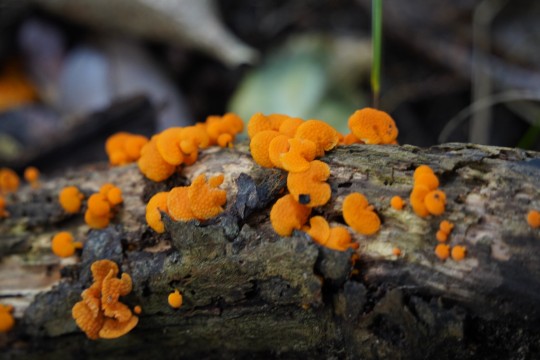


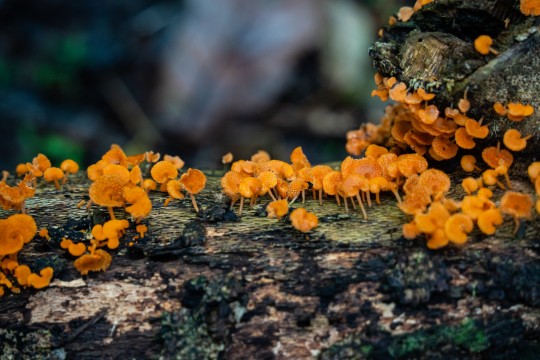
Favolaschia calocera, commonly known as the orange pore fungus, is a species of fungus in the family Mycenaceae. Due to its form it is also known as orange pore conch or orange Ping-Pong bat. Throughout much of its expanded range F. calocera is now considered an invasive species. It colonizes ruderal sites along transport routes and can become dominant in habitats disturbed by human activity. Mycologists fear that it may be displacing native fungi species as it spreads through the paleotropics. Фаволаскія калоцера
Waiwera, Auckland, New Zealand
FP67+PG Waiwera, Auckland, New Zealand
-36.5382000, 174.7138000
0 notes
Text
LACQUERED BRACKET/ GANODERMA LUCIDUM

Identification relies on many characters that are accessible without recourse to microscopic work, although measuring spores is also sometimes informative. The cap is up to 25cm across and 4cm thick. They often have a stalk; fan-shaped or kidney-shaped, most often laterally attached but occasionally almost centrally attached when in sessile form.the colour pallet is yellow, orange, red and purplish zones shading to ochre towards the margin and with a white growing edge; eventually turning purple-brown all over the upper surface and finally blackening. The stem is substantial and they are eccentrically attached to the caps, are broad near the point of attachment and usually narrower towards the stem base. Stems can be up to 20cm in length, although 5 to 15cm is more typical. The red-brown stem and upper cap surface have a varnished gloss, becoming dull and matt when covered in spores. The tubes are white at first, later becoming ochraceous; 5 to 20mm deep and typically spaced at 4 to 6 pores per mm. The small roundish pores are just perceptible to the naked eye; they are white when the fruiting body is young, turning brown with age or when bruised.
In Britain and Ireland the Lacquered Bracket is parasitic mainly at or near the bases of old oak and maple trees or saprobic on the stumps of these and occasionally other recently felled broadleaf trees. This annual bracket fungus releases spores in summer and autumn, but the tough fruitbodies persist for several months.
HARVARD REFERENCE
P. Karst. (2016). Ganoderma lucidum. [Online]. First Nature. Available at: https://www.first-nature.com/fungi/ganoderma-lucidum.php [Accessed 15 April 2023].
0 notes
Text

🍄 Source
#Favolaschia calocera#narancs pórusos gomba#orange pore fungi#természet#nature#erdő#forest#kéreg#bark#moha#moss#ősz#autumn#goblincore#hobbitcore#fairycore#witchcore
1K notes
·
View notes
Text
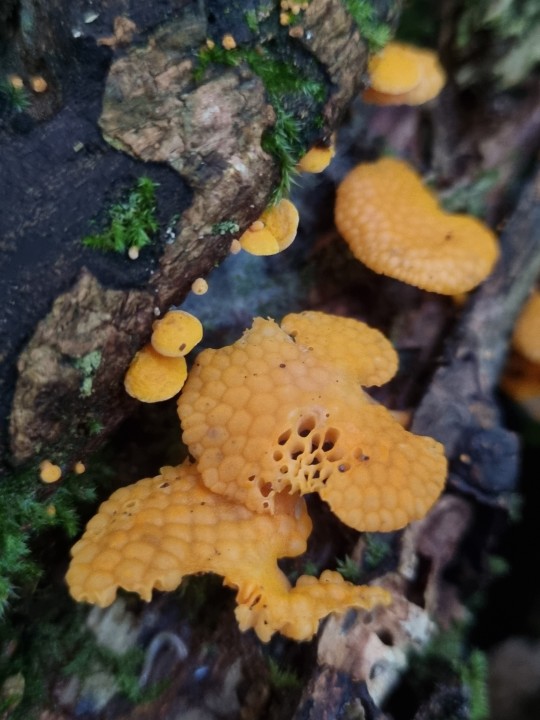
Favolaschia calocera, Orange pore fungus
#fungi#mycology#mushroom#nature#photography#nature photography#mushrooms#toadstools#forest#cornwall#Orange pore fungi
155 notes
·
View notes